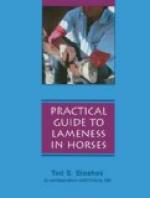In every instance diagnosis is easily established. The injury is quite evident, and the manner of locomotion is not in itself an essential feature to be considered in a discussion of symptoms. Where a contusion of the anterior brachial structures occurs, there is, in addition to lameness, swelling which is painful because of the pressure occasioned by the heavy non-yielding brachial fascia. And where suppuration occurs, there is then an intensely painful condition which is not relieved until pus has been evacuated. Rather frequently, drainage for wound secretions is a difficult problem, and approximation of the divided ends of muscles is always difficult to maintain.
Treatment.—Contused wounds of the anterior brachial region are treated along usual lines; that is, attempt is made to stimulate prompt resolution. Hot or cold applications are employed throughout the acute stage of the affection. Complete rest is provided for until all pain has subsided. Later, stimulating liniments are beneficial.
Where no injury is done the periosteum or bone, complete resorption of all products of inflammation usually occurs, though in many instances, this is tardy—six weeks or more are sometimes required for recovery to take place.
If suppuration occurs, it is necessary to provide for drainage as soon as it is possible to distinguish the presence of pus. Due regard is given the manner of establishing drainage because of the usual existence of sub-fascial fistulae. In these cases, one avoids injecting solutions of aqueous antiseptics. By gently compressing the parts, pus is caused to drain out and in enforcing a moderate amount of exercise at a walk, when lameness is not intense, drainage is maintained. Cotton packs, moistened with hot antiseptic solutions, and kept around the forearm for several hours daily, are helpful because drainage is facilitated, and resolution is stimulated by the increase of blood thus attracted to the parts, and pain materially diminishes.
In lacerated wounds of the anterior brachial region, after having controlled hemorrhage, an area around the wound margin is freed of hair by clipping or shaving. The wound is carefully examined, and the best site for drainage is selected and a suitable opening for wound discharge is provided for. Where the extensor carpiradialis (metacarpi magnus) with other structures, is divided and the distal portion is torn downward, as frequently is the case in barbed wire cuts, it is necessary to make careful provision for drainage. The wound is thoroughly cleansed by means of ablutions if necessary; but preferably by swabbing with pledgets of cotton or gauze which are moistened in antiseptic solutions. All shreds of macerated tissue are clipped with scissors and finally the whole wound surface is painted with tincture of iodin.
If drainage is made by cutting through the tissues in the median portion of the structures that have been displaced, the opening should be packed with gauze so that it may remain patent after swelling has occurred. Such packing is left in situ for twenty-four hours.




